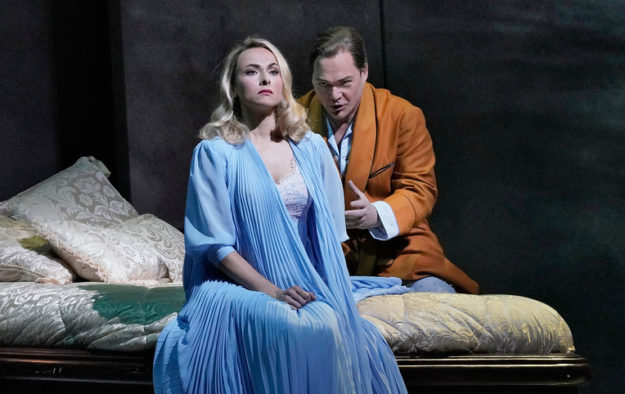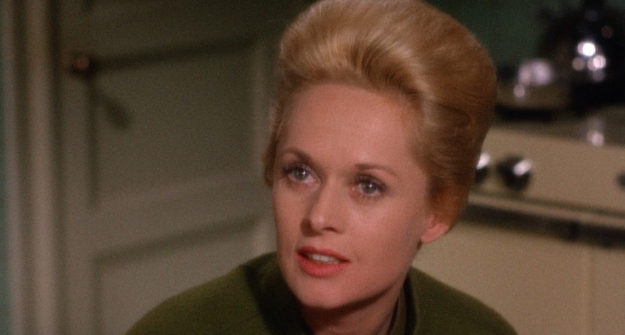Sing Your Life: Marnie at the Met

Credit: Ken Howard / Met Opera
To borrow the aghast tagline for another psychologically fraught movie of the early ’60s: how could they ever make an opera of Marnie? Aside from the ever downward spiral of Bernard Herrmann’s whirlpool of a score and its mega-melodramatic climax, Alfred Hitchcock’s 1964 anti-romantic Freudian drama of repressed neuroses is one of the director’s most tightly wound affairs, moving to the minute, internal rhythms of its shrinking violet title character, played by Tippi Hedren. Explosions of red on screen become the most overtly expressive moments, visual evocations of Marnie’s childhood traumas. Otherwise, she is as coiled as a snake, subsuming her past horrors by eradicating her very self. Her life suggests a process of erasure that might seem the opposite of the emotive, extroversion of opera. Yet as with the musical tradition, song can speak for the repressed emotions we cannot seem to express.
The new production from director Michael Mayer and composer Nico Muhly, opening tonight at the Metropolitan Opera at Lincoln Center (after premiering last year at the English National Opera in London), finds ingenious ways to burrow into its main character’s psyche. We first see a number of large-scale projections of women’s faces in close-up, covering the stage, staring back at us; due to their different hairdos, eyewear, and outfits it’s unclear at first that these are all the same woman. After all, Marnie is a tale of multiple identities. Currently named “Miss Holland,” she is at first difficult to make out amidst a sea of similarly dressed stenographers in an office in 1959 Birmingham, their staccato vocal style somehow approximating the clack-clack of the typewriters. It’s only when the working day is over that we can single her out, as she creeps back into the office after hours, dressed in a luxurious, concealing pea-green overcoat, and proceeds to crack into the safe, robbing the company she works for of thousands of pounds.
As embodied by mezzo-soprano Isabel Leonard, this Marnie is naturally bolder then Hedren’s version, as the intense, emotion-roiled Leonard doesn’t need a camera to project emotion, and that’s even before she opens her mouth to reveal her extraordinary vocal ability. As the opera continues it becomes clearer that this is indeed an entirely different incarnation of the character from the one Hitchcock aficionados have been used to for decades. Especially as she relates to the men in the narrative, this Marnie is less of a victim or even a frighteningly damaged femme fatale than a woman sifting through her past and rewiring her own internal mechanisms to sort out her own life. Unlike in Hitchcock’s film, she doesn’t require the intervention of a concerned, caring man to make this possible. It’s not a redemption narrative; it’s a self-actualization story, concluding in a powerful, unexpected expression of liberation that leaves her alone on the stage, handcuffed but paradoxically free, holding on to no one but herself. By contrast, Hitchcock’s film ends with Tippi Hedren being tenderly escorted into a car by Sean Connery.
Such divergences also reflect the fact that Muhly and librettist Nicholas Wright’s opera is less a remake of Hitchcock’s film than a new adaptation that goes back to the source, Winston Graham’s 1961 novel. The character of Mark Rutland, played by Connery in the movie, is perhaps the most radical difference. In Hitchcock’s film, Mark finds out about Marnie’s transgressions and all but blackmails this woman terrified of being touched by a man into marrying him; he’s another in a line of the director’s vaguely villainous leading men, like Cary Grant’s Devlin in Notorious or Jimmy Stewart’s Scotty in Vertigo. But whereas those figures controlled women to the point of making them lose their identities or sanity, Marnie already begins the film in such a state, so Mark becomes a problem-solver rather than an agitator—despite his frightening intimidation and sexual bullying. In the opera, Mark nearly rapes Marnie aboard a ship on their romance-less honeymoon, which leads to a scary near suicide that closes out the first act. In the film, after feeling emasculated by Marnie’s refusal to consummate, Mark rips off her clothes (Hedren’s nudity represented by bare shoulders and ankles), but then after a change of heart, the mensch takes off his jacket and wraps it around her—all the easier for the audience to accept him as a savior in the film’s second half.

Muhly and Wright have little interest in making Mark cuddly. As in the book the managing director of a printing firm (rather than the wealthy Connery-esque playboy of the film), this Mark is elusive, underhanded, and, as played by baritone Christopher Maltman, menacing. Mark is put into some relief by the presence of his even slimier brother, Terry, who not only has a bright red birthmark covering half of his face but is also performed by a countertenor, Iestyn Davies, whose piercing, high vocal range makes him an anxious presence. Nevertheless, Mark is no here; he’s not here to solve the problem of Marnie, but rather to exacerbate it. “Is this what horror feels like?” Marnie sings after being essentially caught by Mark.
It’s Marnie’s relationship with her adopted, wheelchair-bound mother (Denyce Graves) that instead takes center stage. Here the source of Marnie’s rage and fear is not the suppressed memory of having killed a sailor (memorably played in Hitchcock’s adaptation by a young Bruce Dern) with an iron poker after he attacked her mother. In the opera, as in the book, Marnie is haunted by the death of her baby brother, whom she believes she smothered when she was a child. (In a brilliant bit of Kevin Adams’s lighting design, this traumatic memory manifests on-stage when, during a thunderstorm, a figure appears at the window behind Marnie, holding a baby, only visible when the lightning strikes before again disappearing.) She’s “bad all through,” her mother has convinced her, herself, and everyone, and the guilt has led to Marnie’s dissociation from identity and reality. The truth about this alleged incident becomes the central idea of the play’s final act, and helps to answer the frightening existential question Marnie at one point achingly asks: “Am I how I was made or how I made myself to be?”
Mayer ensures all these swirling neuroses are handled with a cleverness that never undermines the staging’s essential sensitivity to emotional trauma. The most successful and striking idea is to create a kind of Greek chorus of four brightly dressed blondes (representing the various Marnies) who occasionally emerge and surround Marnie when she’s in her most feverish or downcast states. Given to internal dirge-like expression, rumbling with such lyrics as “All . . . night . . . long . . . the guilty hear malevolent voices,” these characters, visible only to the audience, embody what Muhly has called his interest in “ancient musical forms.” Once Marnie can shed herself of these ghosts, perhaps she can move on. Until then, the opera of Marnie allows us the odd, soaring pleasure of being awash in extravagant melancholy.
Marnie runs through November 10 at The Metropolitan Opera.
Michael Koresky is the Director of Editorial and Creative Strategy at Film Society of Lincoln Center; the co-founder and co-editor of Reverse Shot; a frequent contributor to the Criterion Collection; and the author of the book Terence Davies, published by University of Illinois Press.







